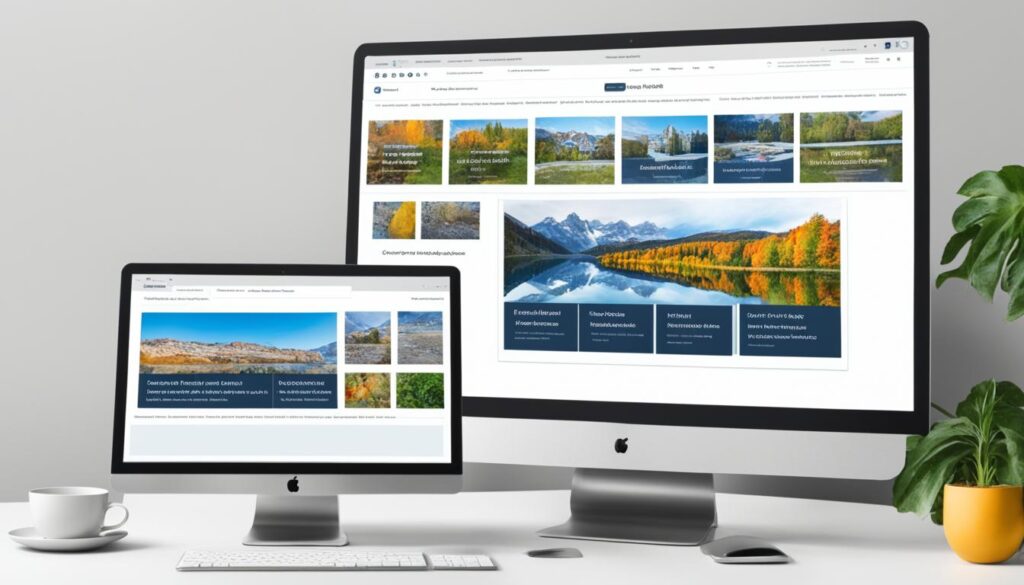Do you want more organic traffic for your WordPress site? Are you curious how WordPress can improve your content marketing? You’ve come to the right place! This piece covers how to use WordPress to make your site more visible. We aim to help you bring in more targeted organic traffic.

SEO and content marketing are crucial in the digital world. WordPress can be a key player in this arena. By using the right methods and tools, you can boost your site’s SEO. This will build a solid base for your site’s ongoing success.
Key Takeaways:
- WordPress offers a range of features and plugins that can enhance your content marketing and SEO efforts.
- Optimizing title tags and meta descriptions is crucial for improving your website’s visibility in search engine rankings.
- Implementing effective link building strategies can help establish your website’s credibility and increase organic traffic.
- Creating a sitemap and making your website accessible are essential for search engine crawlers and improving visibility.
- Regularly analyzing your website’s performance and adapting your strategies is key to maximizing organic traffic growth.
Optimize Title Tags and Meta Descriptions
Optimizing your website’s title tags and meta descriptions is key. It boosts your site’s search engine rankings and draws in organic traffic. These elements highlight your page’s relevance to both search engine bots and future visitors.
Title tags should be short with important keywords at the start. This helps search engines and people quickly get what your page is about. Keeping them concise ensures users understand how it relates to their search.
Meta descriptions let you summarize your page’s content in an engaging way. Write them well, staying under the character limit, to show the value and relevance of your content. A good meta description makes people want to visit your site from the search results, increasing your organic traffic.
Effective title tags and meta descriptions make your site more visible to search engines and visitors. This is a big part of getting higher search result ranks and more targeted organic traffic.
But remember, these elements are just pieces of a bigger SEO puzzle. Including them with other strategies enhances your site’s visibility and organic traffic.
Best Practices for Title Tags and Meta Descriptions
- Include relevant keywords near the beginning of your title tags.
- Keep your title tags concise, ideally within 50-60 characters.
- Create informative and compelling meta descriptions within the recommended character limit of 150-160 characters.
- Use action-oriented language to entice users to click through to your website.
- Ensure that your meta descriptions accurately reflect the content of your page.
- Avoid using duplicate title tags or meta descriptions across different pages of your website.
Optimizing title tags and meta descriptions is a part of improving your website. Using these tips with other SEO methods will help you get the most out of your website. It can boost your visibility in search engines and your organic traffic.
Implement Link Building
Link building boosts your site’s organic traffic and credibility. It involves using internal links and getting backlinks from other sites. This improves your site’s authority and its search engine ranking.
Internal links connect your site’s pages, leading visitors to more content. They help users and show search engines the structure of your site. This can make your site easier to find and index.
Backlinks are links from other sites to yours. They act like votes of confidence, showing search engines your content is valuable. These links can also bring new visitors interested in what you offer.
Here are ways to build links:
- Create great content that others want to link to.
- Ask relevant sites or influencers for backlinks, stressing your content’s value.
- Guest post on well-known sites in your field for backlinks and exposure.
- Keep an eye on the quality and relevance of your backlinks.
Good link building practices increase your site’s authority and search visibility. This leads to more organic traffic.

Set Up A Sitemap
Creating a sitemap for your WordPress site is important for its visibility. An XML sitemap acts like a roadmap for search engines. It lists all URLs on your website.
This helps search engines index your site more easily. A sitemap makes sure search engines find all your pages. It improves the chances of getting more organic traffic. A well-structured sitemap highlights important pages.
Submitting your sitemap to tools like Google Search Console boosts visibility. It lets search engines understand your website better. This improves the search results for users.
Benefits of Setting Up a Sitemap
- Improved website visibility: A sitemap ensures that all your website pages are discovered and indexed by search engines, increasing the chances of them appearing in search results.
- Enhanced search engine crawling: With a sitemap, search engine crawlers can easily navigate and understand your site’s structure, ensuring that all your important pages are crawled and indexed.
- Effective content indexing: A sitemap helps search engines identify and index your valuable content, making it more likely to appear in relevant search results.
- Improved organic traffic: A well-structured sitemap can lead to increased organic traffic as search engines recognize the relevance and quality of your content.
Setting up a sitemap in WordPress is easy. You can use Yoast SEO or Google XML Sitemaps. These plugins help you create and manage your sitemap.
It’s important to update your sitemap when you add or remove pages. This keeps search engines informed about your site’s latest structure and content.

Including a sitemap in your WordPress SEO strategy is key. It helps search engines understand your site better. This leads to better indexing and higher rankings.
Make Your Website Accessible
Making your website more accessible boosts natural visitors. It ensures viewers have a good time on your site. In today’s world, being mobile-friendly is key, as many visit the web on their phones and tablets. By making your site work well on various screens, you reach more people. This helps you rank better in search results too.
It’s important to use descriptive alt text for images and visuals. Alt text helps in two ways. It allows visually impaired individuals to understand what’s on images. It also gives search engines context about the image.
Alt text: A crucial component of inclusive design that benefits both users and search engines.
Inclusion in design is more than being mobile-friendly. It’s about making your site work for everyone, including those with disabilities. Adding video captions, easy-to-use menus, and legible fonts makes a big difference. These changes help people with hearing, movement, or cognitive issues.
Adding these features not only makes your site better for users but also boosts SEO. Search engines prefer sites that are easy to use and accessible. This leads to better rankings and more site visitors.**
So, what does making your site accessible involve?
- Creating a mobile-friendly site for smooth use on all devices
- Using descriptive alt text for images and visuals
- Adding inclusive design elements for users with disabilities
By focusing on accessibility, you make the web more inclusive. This drives more traffic and boosts your site’s SEO performance.

Growing Organically
Growing your website’s organic traffic is key. By honing your website and using smart SEO tactics, you boost visibility. This draws more viewers without paid ads. This part will cover key steps to increase organic traffic and ensure lasting success.
Optimizing Title Tags and Meta Descriptions
Title tags and meta descriptions greatly affect how visible your website is in search results. Use relevant keywords and compelling descriptions to pull in organic traffic. Keep title tags clear and informative. Ensure meta descriptions truly reflect your page’s content.
Improving Website Structure with Link Building
Building links is crucial for boosting your site’s authority and organic traffic. Internal links help search engines grasp your website’s layout and enhance navigation. Meanwhile, backlinks from trusted sites boost your credibility and visibility. This means more organic visitors.
“Link building plays a vital role in increasing organic traffic and establishing your website’s credibility.”
Setting Up a Sitemap
Having a sitemap boosts your site’s visibility. Create an XML sitemap and send it to search engines. It helps them find and index your pages better. This boosts your search result rankings and increases organic traffic chances.
Making Your Website Accessible
Website accessibility matters for inclusivity and organic traffic growth. A mobile-friendly site and adding alt texts to images enhance user experience. This helps search engines understand your content better. It also boosts visibility and organic traffic potential.
To grow organic traffic, keep assessing your site’s performance. Monitor keyword rankings and tweak your SEO strategies for better organic growth. Consulting SEO experts can offer insights and help for sustained organic traffic success.

Next, let’s dive deeper into organic traffic. We’ll see why it’s crucial for attracting targeted, cost-effective visitors to your site.
What is Organic Traffic and Why Does it Matter?
Organic traffic is when visitors find your website through unpaid search engine results. It’s a cost-effective method to bring targeted visitors to your site. It’s key to know why organic traffic matters for effective strategy planning.
Organic traffic is seen as credible and trustworthy by users. If your site appears in organic search results, it’s viewed as reliable. This improves your brand’s image and increases user trust, leading to more conversions.
Organic traffic is also great as it lasts over time. You don’t need to keep spending money like with paid ads. It offers a steady flow of visitors for free, making it a solid long-term investment.
Moreover, organic traffic often gets more clicks than paid ads. People think organic results are more relevant. By focusing on organic traffic, you attract visitors truly interested in what you offer.
Also, organic traffic brings long-term benefits to your website. Once you rank high in search results, your site keeps attracting visitors. This happens without spending more on ads, making organic traffic a cost-effective choice.
Building organic traffic boosts your position as an expert in your niche. As more people visit your site organically, you become a go-to source. This enhances your brand and establishes you as an industry leader.
In short, organic traffic is vital for bringing targeted, affordable visitors to your site. Its benefits include credibility, longevity, cost-saving, and building authority. By enhancing your site’s SEO for organic traffic, you pave the way for success.

How to Generate Organic Traffic for Your Website: 9+ Tips
Getting organic traffic involves using different SEO best practices. By doing this, you can bring more targeted organic visitors to your WordPress site. It also boosts visibility on search results.
1. Use the Right WordPress SEO Tool
Choose a top WordPress SEO plugin like All In One SEO for effective SEO. This tool helps with keyword optimization, creating XML sitemaps, and analyzing content. It’s great for increasing organic traffic.
2. Conduct Proper Keyword Research
Doing thorough keyword research is essential. It helps you understand what your audience is searching for. Find relevant, high-volume keywords to make your content more attractive.
3. Follow SEO Best Practices for On-Page Optimization
Make your site’s pages better by optimizing key elements like title tags and meta descriptions. Use keywords naturally. Make sure your content is organized and easy to read.
4. Optimize for Featured Snippets
Try to get your content in featured snippet boxes in search results. You can do this by giving clear answers to common questions in your field.
5. Build Strategic Backlinks
Get good backlinks from well-known sites in your industry. This can improve your site’s authority and visibility. It brings more visitors from other sites too.
6. Combat Content Decay
Keep your content up to date to fight content decay. Always add new insights or case studies. This keeps it useful for both users and search engines.
7. Implement a Content Marketing Strategy
Create content that speaks to your audience. Regularly sharing quality content boosts visibility, draws more visitors, and establishes you as a leader in your field.
8. Leverage Social Media Marketing
Use social media to promote your site and content. This broadens your audience and brings more visitors. Engage with your followers and share helpful information.
9. Continuously Monitor and Improve Your SEO Efforts
Keep an eye on how your site is doing, including keyword rankings and traffic. Use this data to make your SEO strategies better and grow your traffic.
By following these tips and being persistent, you can increase organic traffic on your WordPress site. This improves your standing in search engine results.

Next, we’ll look at real-world examples of how to grow organic traffic successfully. This will give more insight and inspiration.
Organic Traffic Case Studies
Looking at successful case studies can teach us a lot. It shows how good strategies can boost organic traffic. These real-world examples help us understand what works.
E-commerce Site Case Study
An e-commerce site selling handmade candles saw its organic traffic jump in three months. The site began creating high-quality blog posts and videos. These covered candle making, decoration ideas, and gift tips. They also improved their website with keywords and SEO tools. Active social media engagement helped too. It led to more shares and links, boosting traffic and sales.
Niche Blog Case Study
A blog about sustainable living grew its organic traffic in six months. It posted articles on zero-waste living, green renovations, and product reviews. The site did its homework on keywords and optimized its content well. This attracted a loyal community. They shared posts and linked back to the blog. This made the blog a top resource for sustainable living.
These examples show the importance of good strategies for growing organic traffic. Using content marketing, SEO, and social media can lead to success. These stories can inspire your WordPress website’s strategy.
| Case Study | Website Type | Time Frame | Organic Traffic Growth |
|---|---|---|---|
| E-commerce Site | Handmade candle shop | 3 months | Significant increase |
| Niche Blog | Sustainable living | 6 months | Substantial growth |
These studies show that the right strategies can lead to big gains in organic traffic. By learning from these examples, you can find success too. Adapt their strategies for your WordPress site.
Conclusion and Next Steps
Making your WordPress site better for organic traffic is a planned and ongoing task. To do this, you can improve title tags and meta descriptions. Also, develop link-building strategies, create a sitemap, and ensure your website is easy to access. These steps can boost your site’s presence and draw in more targeted organic traffic.
The work to get more organic traffic doesn’t stop here, though. It’s important to keep an eye on how your site is doing, check how your keywords are performing, and stay up-to-date with the newest ways to make your WordPress site better. This regular checking, analyzing, and updating of your SEO plan is key to long-term success.
For a deeper dive into getting organic traffic, think about working with SEO experts. They can offer helpful advice and direction that suits your website. As you keep moving forward with site optimization, remember to learn and improve your methods. This will help you stay ahead in the competitive world of gaining organic traffic.
By taking these steps and focusing on improving your WordPress site, you set the stage for continued organic traffic growth. This will help you meet your goals for making your site more visible.